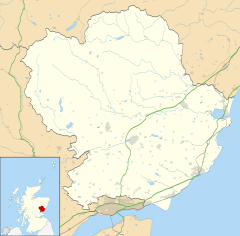Strathmartine
Appearance
| Strathmartine | |
|---|---|
Location within Angus | |
| OS grid reference | NO387348 |
| Council area | |
| Lieutenancy area | |
| Country | Scotland |
| Sovereign state | United Kingdom |
| Post town | DUNDEE |
| Postcode district | DD4 |
| Dialling code | 01382 |
| Police | Scotland |
| Fire | Scottish |
| Ambulance | Scottish |
| UK Parliament | |
| Scottish Parliament | |
Strathmartine is an area of Angus, Scotland (named after a local mythical hero, Strathmartin The Dragonslayer).[1] It is to the north of Dundee[2] and the surrounding district is often referred to as "the Howe o Strathmartine".
The parishes of Mains and Strathmartine were united on 21 Nov 1792. Anciently, Mains was called Earl's Strathdichty, Strathmartine was called Strathdichty Martin. The Dichty Water flows through the parishes.[3][4]
William Lorimer, the classicist, known for producing a translation of the New Testament in Lowland Scots was born in Strathmartine. Baldovan village to the north is home to Strathmartine Hospital which is a long stay hospital for people with severe learning disabilities.


References
- ^ Shand, William. "The Dundee Dragon". The Dundee Messenger. Retrieved November 11, 2013.
- ^ "Dundee and Montrose, Forfar and Arbroath", Ordnance Survey Landranger Map (B2 ed.), 2007, ISBN 0-319-22980-7
- ^ "Mains and Strathmartine". Retrieved November 11, 2013.
- ^ Warden, Alex J (1880). Angus or Forfarshire, the land and people, descriptive and historical. Vol. II. pp. 252–253. Retrieved November 22, 2013.
External links
Wikimedia Commons has media related to Strathmartine.

